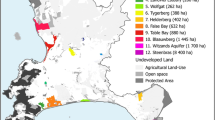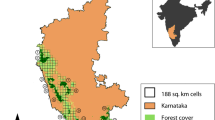Abstract
Small reserves are especially likely to lose species. Is that because the reserves are small, or because small reserves are located in especially adverse landscapes? It seems that the question has rarely, if ever, been asked. Data on reserve size and location in Africa, and calculations of local (within 50 km) mean human densities from available census records per province per country were the database here used to answer the question. IUCN grade I and II reserves in Africa are located across the range of human densities per country, including in regions of higher than average density. Furthermore reserve size correlates with local human density, such that small reserves are indeed significantly more likely than are large reserves to be located in regions of high human density (n = 169; P < 0.0001). However, while local human density correlates significantly with human-caused mortality of carnivores (the only taxon for which we had data), it does not correlate with detected extinctions in reserves in east Africa (the only region with available data). Rather, area of reserve is the main predictor. Nevertheless, abundant other evidence of the adverse effects of high human density on persistence of species and wilderness indicates that we need to take as a warning the findings reported here that small reserves occur in regions of high human density, and that human density correlates with human-caused mortality. They indicate that small reserves might face the double jeopardy of both their small size, and also their situation in especially hostile surroundings. In effect, small reserves are more isolated in more adverse habitat than current analyses in conservation biology, landscape ecology, or metapopulation analysis usually indicate.
Similar content being viewed by others
References
Andrén H (1995) Effects of landscape composition on predation rates at habitat edges. In: Hansson L,Fahrig L andMerriam G (eds) Mosaic Landscapes and Ecological Processes, pp 225-255. Chapman & Hall, London
Ayres JM,Bodmer RE andMittermeier RA (1991) Financial considerations of reserve design in countries with high primate diversity. Conservation Biology 5: 109-114
Barnes RFW (1990) Deforestation trends in tropical Africa. African Journal of Ecology 28: 161-173
Bawa KS andDayanandan S (1997) Socioeconomic factors and tropical deforestation. Nature 386: 562-563
Belovsky GE (1987) Extinction models and mammalian persistence. In: Soulé ME (ed) Viable Populations for Conservation, pp 35-57. Cambridge University Press, Cambridge
Brooks T andBalmford A (1996) Atlantic forest extinctions. Nature 380: 115
Brooks TM,Pimm SL andCollar NJ (1997) Deforestation predicts the number of threatened birds in insular Southeast Asia. Conservation Biology 11: 382-394
Brown JH (1971) Mammals on mountaintops: nonequilibrium insular biogeography. American Naturalist 105: 467-478
Burkey TV (1995) Faunal collapse in East African game reserves revisited. Biological Conservation 71: 107-110
Cowlishaw G (1999) Predicting the pattern of decline of African primate diversity: an extinction debt from historical deforestation. Conservation Biology 13: 1183-1193
Cox DR (1970) The Analysis of Binary Data. Methuen, London
Debinski DM andHolt RD (2000) A survey and overview of habitat fragmentation experiments. Conservation Biology 14: 342-355
Diamond JM (1975) The island dilemma: lesson of modern biogeographic studies for the design of natural reserves. Biological Conservation 7: 129-146
Diamond JM (1984) 'Normal' extinctions of isolated populations. In: Nitecki MH (ed) Extinctions, pp 191-246. University of Chicago Press, Chicago
ESRI Inc. (1998a) ARC/INFO, 7.1.2. Environmental Systems Research Institute, Inc., Redlands, California
ESRI Inc. (1998b) ArcView GIS, 3.1. Environmental Systems Research Institute, Inc., Redlands, California
Hannah L,Lohse D,Hutchinson C,Carr JL andLankerani A (1994) A preliminary inventory of human disturbance of world ecosystems. Ambio 23: 246-250
Hanski IA andGilpin ME (eds) (1997) Metapopulation Biology. Ecology, Genetics, and Evolution. Academic Press, San Diego, California
Hansson L,Fahrig L andMerriam G (eds) (1995) Mosaic Landscapes and Ecological Processes. Chapman & Hall, London
Harcourt AH (1981) Can Uganda' gorillas survive? A survey of the Bwindi Forest Reserve. Biological Conservation 19: 269-282
Harcourt AH (1996) Is the gorilla a threatened species? How should we judge? Biological Conservation 75: 165-176
Harcourt AH (1998) Ecological indicators of risk for primates, as judged by susceptibility to logging. In: Caro TM (ed) Behavioral Ecology and Conservation Biology, pp 56-79. Oxford University Press, New York
Harcourt AH andSchwartz MW (2001) Primate evolution: a biology of Holocene extinction and survival on the South-East Asian Sunda Shelf Islands. American Journal of Physical Anthropology 114: 4-17
Heaney LR (1984) Mammalian species richness on islands on the Sunda Shelf, southeast Asia. Oecologia 61: 11-17
Hoare RE andDu Toit JT (1999) Coexistence between people and elephants in African savannas. Conservation Biology 13: 633-639
Hunter ML and Yonzon P (1993) Altitudinal distributions of birds, mammals, people, forests, and parks in Nepal. Conservation Biology 7: 420-423
Iremonger S,Ravilious C andQuinton T (eds) (1997) A Global Overview of Forest Conservation CD-ROM. WCMC and CIFOR, Cambridge, UK
IUCN (1996) 1996 IUCN Red List of Threatened Animals. IUCN, Gland, Switzerland
Jablonski D (1991) Extinctions: a paleontological perspective. Science 253: 754-757
Jernvall J andWright PC (1998) Diversity components of impending primate extinctions. Proceedings of the National Academy of Sciences, USA 95: 11 279-11 283
Johns AD andSkorupa JP (1987) Responses of rain-forest primates to habitat disturbance: a review. International Journal of Primatology 8: 157-191
Kerr JT andCurrie DJ (1995) Effects of human activity on global extinction risk. Conservation Biology 9: 1528-1538
Laurance WF (1990) Comparative responses of five arboreal marsupials to tropical forest fragmentation. Journal of Mammalogy 71: 641-653
Laurance WF (1991) Ecological correlates of extinction proneness in Australian tropical rain forest mammals. Conservation Biology 5: 79-89
Laurance WF andBierregaard RO (eds) (1997) Tropical Forest Remnants. University of Chicago Press, Chicago
Leach MK andGivnish TJ (1996) Ecological determinants of species loss in remnant prairies. Science 273: 1555-1558
Leader-Williams N andAlbon SD (1988) Allocation of resources for conservation. Nature 336: 533-535
Leader-Williams N,Harrison J andGreen MJB (1990) Designing protected areas to conserve natural resources. Science Progress Oxford 74: 189-204
Lomolino MV,Brown JH andDavis R (1989) Island biogeography of montane forest mammals in the American Southwest. Ecology 70: 180-194
MacArthur RH (1972) Geographical Ecology. Patterns in the Distribution of Species. Princeton University Press, Princeton
McNeely JA,Gadgil M,Levèque C,Padoch C andRedford K (1995) Human influences on biodiversity. In: Heywood VH andWatson RT (eds) Global Biodiversity Assessment, pp 711-821. Cambridge University Press, Cambridge
Mittermeier RA,Myers N,Thomsen JR,da Fonseca GAB andOlivieri S (1998) Biodiverity hotspots and major tropical wilderness areas: approaches to setting conservation priorities. Conservation Biology 12: 516-520
Muchaal PK andNgandjui G (1999) Impact of village hunting on wildlife populations in the western Dja Reserve, Cameroon. Conservation Biology 13: 385-396
Myers N,Mittermeier RA,Mittermeier CG,da Fonseca GAB andKent J (2000) Biodiversity hotspots for conservation priorities. Nature 403: 853-858
Naveh Z andLieberman AS (1994) Landscape ecology: theory and application, 2nd edn. Springer-Verlag, New York
Newmark WD (1995) Extinction of mammal populations in western American national parks. Conservation Biology 9: 512-526
Newmark WD (1996) Insularization of Tanzanian parks and local extinction of large mammals. Conservation Biology 10: 1549-1556
Parker ISC andGraham AD (1989) Men, elephants, and competition. Symposia of the Zoological Society of London 61: 241-252
Pimm SL (1991) The Balance of Nature. University of Chicago Press, Chicago
Robinson JG,Redford KH andBennett EL (1999) Wildlife harvest in logged tropical forests. Science 284: 595-596
Rosenzweig ML (1995) Species Diversity in Space and Time. Cambridge University Press, Cambridge
SAS Institute Inc. (1995) JMP, 3.2.2. SAS Institute Inc., Cary, North Carolina
Sokal RR andRohlf FJ (1981) Biometry. The Principles and Practice of Statistics in Biological Research. W.H. Freeman and Co., San Francisco
Soulé ME,Wilcox BA andHoltby C (1979) Benign neglect: a model of faunal collapse in the game reserves of East Africa. Biological Conservation 15: 259-272
Terborgh J (1974) Preservation of natural diversity: the problem of extinction prone species. Bioscience 24: 715-722
Turner IM (1996) Species loss in fragments of tropical rain forest: a review of the evidence. Journal of Applied Ecology 33: 200-209
Van Vuren D (1998) Mammalian dispersal and reserve design. In: Caro TM (ed) Behavioral Ecology and Conservation Biology, pp 369-393. Oxford University Press, New York
Western D andSsemekula J (1981) The future of the savanna ecosystems: ecological islands or faunal enclaves? African Journal of Ecology 19: 7-19
Wiens JA (1997) Metapopulation dynamics and landscape ecology. In: Hanski IA andGilpin ME (eds) Metapopulation Biology. Ecology, Genetics and Evolution, pp 43-62. Academic Press, San Diego, California
Wilcox BA (1980) Insular ecology and conservation. In: Soulé ME andWilcox BA (eds) Conservation Biology. An Evolutionary-Ecological Perspective, pp 95-117. Sinauer, Sunderland, Massachusetts, USA
Wilson EO andWillis EO (1975) Applied biogeography. In: Cody ML andDiamond JM (eds) Ecological Structure of Species Communities, pp 522-534. Harvard University Press, Cambridge
Woodroffe R andGinsberg JR (1998) Edge effects and the extinction of populations inside protected areas. Science 280: 2126-2128
World Resources Institute (1995) Africa Data Sampler CD. World Resources Institute, Washington, DC
Author information
Authors and Affiliations
Rights and permissions
About this article
Cite this article
Harcourt, A., Parks, S. & Woodroffe, R. Human density as an influence on species/area relationships: double jeopardy for small African reserves?. Biodiversity and Conservation 10, 1011–1026 (2001). https://doi.org/10.1023/A:1016680327755
Issue Date:
DOI: https://doi.org/10.1023/A:1016680327755




